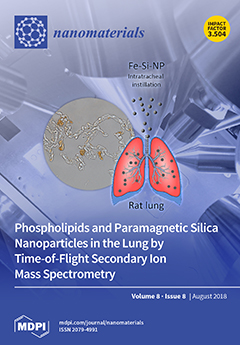There are few reports on zero-field-cooled (ZFC) magnetization measurements for Fe@FeO
x or FeO
x particles synthesized by laser ablation in liquids (LAL) of Fe, and the minimum blocking temperature (T
B) of 120 K reported so far is still much higher
[...] Read more.
There are few reports on zero-field-cooled (ZFC) magnetization measurements for Fe@FeO
x or FeO
x particles synthesized by laser ablation in liquids (LAL) of Fe, and the minimum blocking temperature (T
B) of 120 K reported so far is still much higher than those of their counterparts synthesized by chemical methods. In this work, the minimum blocking temperature was lowered to 52 K for 4–5 nm α-Fe
2O
3 particles synthesized by femtosecond laser ablation of Fe in acetone. The effective magnetic anisotropy energy density (K
eff) is calculated to be 2.7–5.4 × 10
5 J/m
3, further extending the K
eff values for smaller hematite particles synthesized by different methods. Large amorphous-Fe@α-Fe
2O
3 and amorphous-Fe@C particles of 10–100 nm in diameter display a soft magnetic behavior with saturation magnetization (M
s) and coercivities (H
c) values of 72.5 emu/g and 160 Oe at 5 K and 61.9 emu/g and 70 Oe at 300 K, respectively, which mainly stem from the magnetism of amorphous Fe cores. Generally, the nanoparticles obtained by LAL are either amorphous or polycrystalline, seldom in a single-crystalline state. This work also demonstrates the possibility of synthesizing single-crystalline α-Fe
2O
3 hematite crystals of several nanometers with (104), (113), (116) or (214) crystallographic orientations, which were produced simultaneously with other products including carbon encapsulated amorphous Fe (a-Fe@C) and Fe@FeO
x core-shell particles by LAL in one step. Finally, the formation mechanisms for these nanomaterials are proposed and the key factors in series events of LAL are discussed.
Full article






